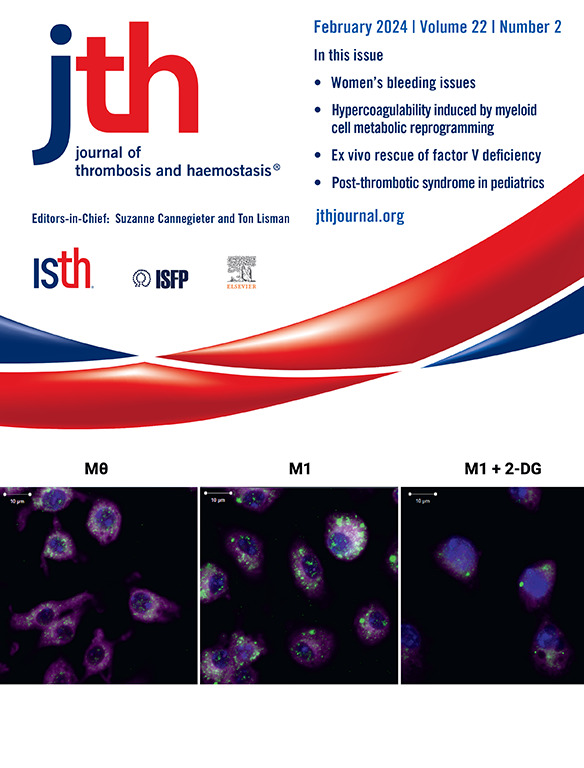Chromogenic vs one-stage assay to diagnose women and girls with hemophilia A—mapping global approaches and assessing challenges: communication from the SSCs of the ISTH
IF 5
2区 医学
Q1 HEMATOLOGY
引用次数: 0
Abstract
Background
Assay discrepancies are well recognized in diagnosing men and boys with hemophilia A (MBwHA), but are not well studied in women and girls with hemophilia A (WGwHA).
Objectives
To survey hemophilia providers to map global approaches/perspectives/challenges in diagnosing WGwHA with a chromogenic assay (CSA) vs one-stage assay (OSA) and other diagnostic tools to diagnose WGwHA compared with MBwHA.
Methods
The International Society on Thrombosis and Haemostasis Scientific and Standardization Committees on FVIII, FIX and Rare Coagulation Disorders and Pediatric and Neonatal Thrombosis and Haemostasis convened a working group, which compiled a Research Electronic Data Capture survey and disseminated it to global hemophilia providers. Descriptive statistics were applied to survey results.
Results
Of 174 respondents, 95% were hemophilia providers, comprising 34% adult hematologists, 58% pediatric hematologists, 2% nurse practitioners, and 0.5% nurses; 95% were providers for WGwHA and WGwHMB. The results showed that CSA with/without OSA is ordered by fewer providers in women and girls (WG, 35%) than in men and boys (MB, 61%; P < .001). OSA is ordered by more providers (62%) in WGwHA due to various assay-related reasons. Bleeding Assessment Tool and genetic testing were not used to diagnose WGwHA by 29% and 33%, respectively.
Conclusion
Based on our survey results, CSA is ordered less frequently in diagnosing WGwHA compared with MBwHA, likely due to assay-related factors including cost, availability, and insurance coverage, and possibly due to some providers not considering assay discrepancies in WGwHA. Increasing global availability and improving provider consideration of assay discrepancies in WGwHA can increase use of both assays. Improved use of assays and other diagnostic tools, such as Bleeding Assessment Tool scores, will improve effective diagnoses of WGwHA.
诊断妇女和女孩A型血友病的显色与一期试验——绘制全球方法和评估挑战:来自ISTH的ssc的交流。
背景:检测差异在诊断男性和男孩A型血友病(MBwHA)时得到了很好的认识,但在诊断女性和女孩A型血友病(WGwHA)时还没有得到很好的研究。目的:调查血友病提供者,以绘制全球方法/观点/挑战,以CSA与OSA诊断WGwHA,以及与MBwHA相比诊断WGwHA的其他诊断工具。方法:ISTH关于因子VIII,因子IX和罕见凝血障碍以及儿科和新生儿止血和血栓形成的ssc召集了一个工作组,编制了REDCap®调查并传播给全球血友病提供者。调查结果采用描述性统计。结果:174名受访者中,95%是血友病提供者;成人血液学家34%,儿科血液学家58%,执业护士2%,护士0.5%;95%为WGwHA和WGwHMB提供服务。结论:根据我们的调查结果,在诊断WGwHA时,与MBwHA相比,CSA在诊断WGwHA时的使用频率较低,这可能是由于与检测相关的因素,包括成本、可获得性和保险范围,也可能是由于一些供应商没有考虑到WGwHA的检测差异。增加全球可用性和改善提供者对WGwHA中测定差异的考虑可以增加两种测定方法的使用。我们希望改进检测方法和其他诊断工具(如BAT评分)的使用,将提高对WGwHA的有效诊断。
本文章由计算机程序翻译,如有差异,请以英文原文为准。
求助全文
约1分钟内获得全文
求助全文
来源期刊
CiteScore
24.30
自引率
3.80%
发文量
321
审稿时长
1 months
期刊介绍:
The Journal of Thrombosis and Haemostasis (JTH) serves as the official journal of the International Society on Thrombosis and Haemostasis. It is dedicated to advancing science related to thrombosis, bleeding disorders, and vascular biology through the dissemination and exchange of information and ideas within the global research community.
Types of Publications:
The journal publishes a variety of content, including:
Original research reports
State-of-the-art reviews
Brief reports
Case reports
Invited commentaries on publications in the Journal
Forum articles
Correspondence
Announcements
Scope of Contributions:
Editors invite contributions from both fundamental and clinical domains. These include:
Basic manuscripts on blood coagulation and fibrinolysis
Studies on proteins and reactions related to thrombosis and haemostasis
Research on blood platelets and their interactions with other biological systems, such as the vessel wall, blood cells, and invading organisms
Clinical manuscripts covering various topics including venous thrombosis, arterial disease, hemophilia, bleeding disorders, and platelet diseases
Clinical manuscripts may encompass etiology, diagnostics, prognosis, prevention, and treatment strategies.

 求助内容:
求助内容: 应助结果提醒方式:
应助结果提醒方式:


